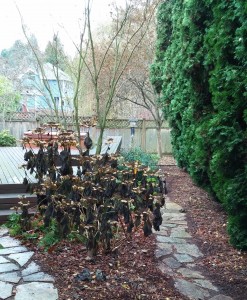Our normally mild corner of the country got hit early and hard with cold weather a few weeks ago. For several days straight, our home thermometer read anywhere from 22-25F. Now, Seattle routinely gets temperatures this low sometime during the winter. But this cold spell came very early – much earlier than our regionally adapted trees and shrubs were used to. The effect on our plants was significant.
 Rhodies react to cold but tolerate the freezing temperatures
Rhodies react to cold but tolerate the freezing temperatures
Trees and shrubs start getting ready for dormancy in the summer. They key in on the progressively shorter days and make biochemical preparations that are unnoticeable. When the first frosty evenings arrive, leaf color changes begin immediately. Chlorophyll, proteins and sugars are scavenged and stored in trunks and roots – we see leaves change from green to red, orange, yellow, and eventually brown. Slowly an abscission layer is laid down at the base of the leaf petiole, and when the layer is complete the leaf dies and falls.
But this year the trees weren’t ready. It got cold really fast, and green leaves died on the trees. And they are still there. Eventually these old leaves will fall, though some of them may stay on until spring.
 Both the hydrangea in the foreground and the styrax in the back have retained their leaves after the cold snap.
Both the hydrangea in the foreground and the styrax in the back have retained their leaves after the cold snap.
What does this mean in terms of tree health? Well, it won’t kill them, but it does set them back in terms of food storage. A lot of the nutrients that were still in the leaves when they froze are lost to the tree. So there may not be as many reserves for winter root growth, or for spring leaf flush. Overall, we could expect to see less than normal growth in established trees and shrubs.
Here in New England, in my very own yard, I’ve been wondering about the few trees that were left with green leaves after virtually all the others in the neighborhood had followed a normal fall progression and were finally bare. The green leaves eventually froze on the trees. Do you think it might be the case that these abnormal trees (ornamental and fruit, purchased at a local nursery) would behave normally if grown in a different zone? Are they planted in the wrong place?
Colorado’s Front Range had a day where we went from 60s F to teens in just a few hours, then single digits the next night then well below zero F the next night. Woodies not hardened off due to prolonged warm fall. Pueblo, Colo was in the 80s F then into the teens with same front. This after two straight springs with abnormally late hard freeze that killed spring buds.
Best,
D
I always thought it odd that the leaves of the Catalpas here in Minneapolis/St.Paul typically freeze off with no leaf drop.
I was noticing the frozen leaves on my Clematis Montana rubens this morning. I had planned on giving it its every third year cut back to ankle height next spring after bloom, but I may wait to see how it comes back from the early hard freeze. I do pay attention to your lectures!
Here in Calgary, we had an unexpected heavy snowfall at the beginning of September when trees were not even thinking about hardening off. Here is what happened: